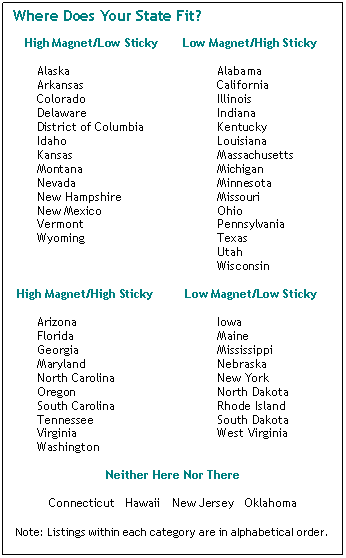Beltane Early Growth Moon
Sister Mary discovered an interesting analysis by the Pew Trust which measured states as  magnetic and sticky. Essentially magnetic meant the capacity, demonstrated by census data, to attract newcomers while sticky measured the capacity or lack of it to retain those born in the state. States received rankings on both measures and then were grouped into categories such as high magnet/low sticky, low magnet/low sticky and so on.
magnetic and sticky. Essentially magnetic meant the capacity, demonstrated by census data, to attract newcomers while sticky measured the capacity or lack of it to retain those born in the state. States received rankings on both measures and then were grouped into categories such as high magnet/low sticky, low magnet/low sticky and so on.
Minnesota and Indiana are in the same group, along with surprisingly, California. That is, neither state attracts all that many new folks, but those born there tend to stay.
I’m not sure why folks remain in Indiana, except for inertia, but I’m sure folks stay in Minnesota because it offers a distinctive culture, one rooted in an outdoor life-style coupled with progressive politics and a highly developed arts and performing arts scene in the Twin Cities. All this set in a spot tucked up next to Canada with the boreal forest extending almost to the northern exurb of the Twin Cities where Kate and I live, a forest filled with lakes and wilderness bounded on its eastern edge by the largest fresh water lake in the world, Lake Superior. (Lake Baikal has more depth and therefore more water, but its surface area is somewhat smaller than the shallower Superior.)
Having said that I moved here by accident when I came for seminary in 1970 and remained by choice. Minnesota is a low magnet state for several reasons, the chief one being climate. We have, or had, severe winters coupled with short but intense summers. Another factor working against Minnesota is its location. It’s not on the way to anywhere in the US. You have to come here on purpose, either for school or outdoor recreation or a work related move. The Upper Midwest, of which Minnesota is a part with Wisconsin and Michigan all share that sense of isolation from the more southerly tiers of states. And you’ll notice they are in the same column.
Indiana does not attract folks, especially now, I imagine, due to poor job prospects. The closing of industrial manufacturing facilities put Indiana solidly in the rust belt. It does not have the natural amenities of the hills and mountains of Tennessee, Kentucky, Arkansas, nor does it have any other particularly noteworthy natural features. It does have a strong blue collar culture focused on basketball, cars, racing and the remnants of unionism which might help explain why folks stay.
The whole article on the Pew website is worth reading. They do very interesting work on several topics.
